It provides the foundation for all your favourite movies and TV shows. The blueprint for every short film or piece of theatre you’ve ever seen. Some (very fortunate) people will get paid millions to write one. The other 99% can only dream of being paid to write one at all. I am of course talking about… the script.
This article will take you through the process of how to write a script. We’ll cover everything from creating the initial idea and structuring your story, to planning, writing and formatting a movie script. This is so that one day you too can get paid millions to write a masterpiece of your own.
How To Write A Script & Why You Need One

Before we jump into how you actually go about writing a script, it’s good to understand exactly why you need a script. Keeping the story in your head, or in some form of loose notes, isn’t going to cut it when you’re collaborating with numerous people.
The first big reason to write a script is to make production as smooth as possible. Producers, for example, can take one look at any given scene in your script and see exactly how many cast members are required, what type of location is needed, and whether the shoot will need to take place indoors or outdoors.
The cinematographer can also see whether they’re going to be lighting a scene to look like day or night. Each of these will have a huge effect on the lighting set-up required. Finally, and most obviously, it tells your actors exactly what to say, when to say it, and what actions they should be performing. It’s a blueprint for your movie or other chosen medium.
The next big reason comes when it’s time to pitch your movie or TV show idea. A script gives the studio exec or producer an idea of the story, tone, characters, and roughly how much it’s going to cost to make.
Idea Generation For Scriptwriting
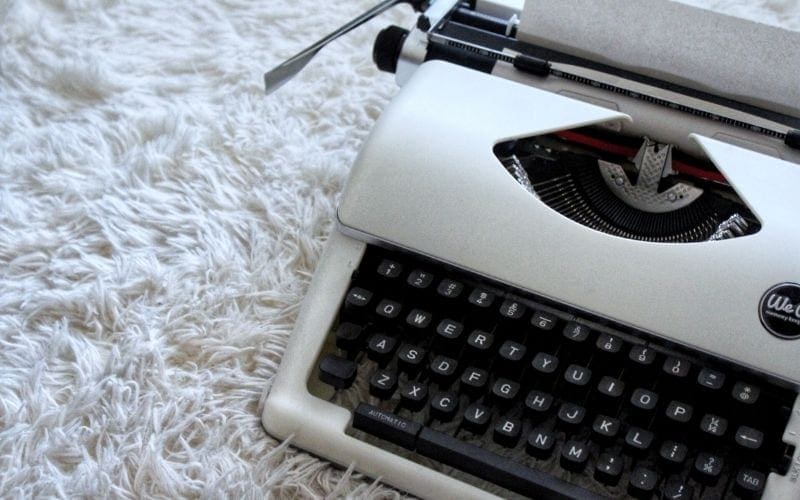
So we know why we need a script, now it’s time to begin. But where do you start? Well, first you need an idea. Hopefully you know roughly what type of story you want to tell. In case you don’t, here are a few pointers and tips to help with generating ideas.
The first (and best) way to do this is to watch and read as much narrative content as possible. Try and pick up on an interesting scenario or character that you could put your own spin on. If this isn’t quite working, then you could always try creating a random character and giving them a goal that’s almost impossible to achieve. It then becomes your job as a writer to make them succeed against all odds. Writing your way out of a corner like this can be as thrilling for you to write, as it is for the audience to watch.
Failing all of this, you could go to Google and search for a movie plot generator. Or you can look for writing prompts websites. R/writingprompts on Reddit is a good place to start. This may seem like a bit of a cop-out, but you’d be surprised how often something this basic can provide the spark for a much more complex idea.
Planning Your Script When Screenwriting
Now you’ve established a basic premise, so what’s the first thing you should do when writing a script? The answer… is don’t write the script! Before you even write your first scene heading, there’s plenty of planning and structuring you should do in order to make your scriptwriting life as easy as possible.
There are many reasons not to jump straight into your screenwriting software and begin to write. The main reason being writer’s block. We’ve all been there, sat in front of your laptop staring at the screen for hours with no idea where to start or where to go. Writer’s block is a demon best prevented, not reacted to, and planning your story thoroughly is the best way to avoid it.
Try to take your basic premise and turn it into a logline. A logline is a one-sentence summary of the main conflict, emotional hook, or plot line for your story. This really streamlines and focuses the story that you’re trying to tell. From there you can flesh this out into a treatment, which is a more detailed but still condensed version of the whole story. To do this, you can follow a set narrative structure.
What Is Narrative Structure?
Narrative structure provides the structural framework that your story should follow and almost provides a literary to-do list for your narrative. It provides the building blocks for how and when the main story beats of a movie or TV show occur. If you can learn how to write beats in a script, you will create some brilliant work. So, what are the main narrative structures you can follow? Here’s a few of the most common:
3 Act Structure

5 Act Structure
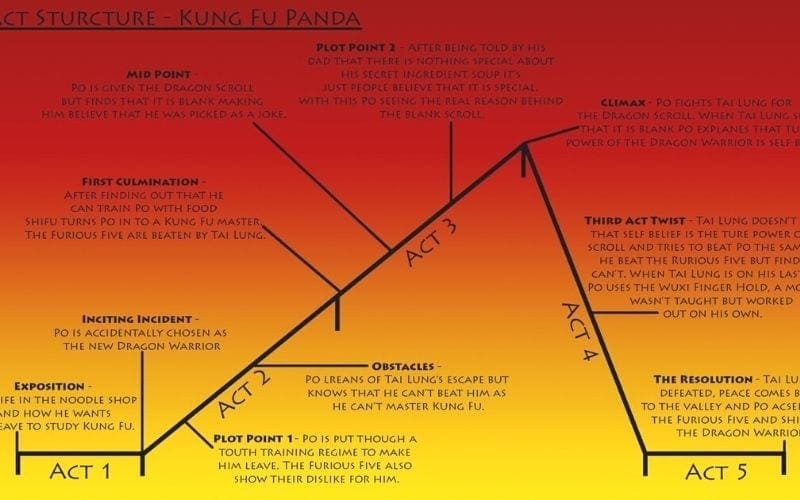
Hero’s Journey
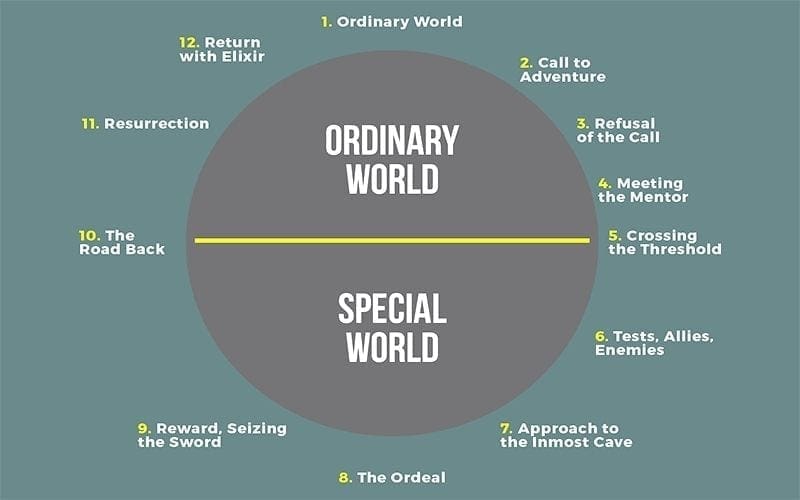
Dan Harmon’s Story Circle
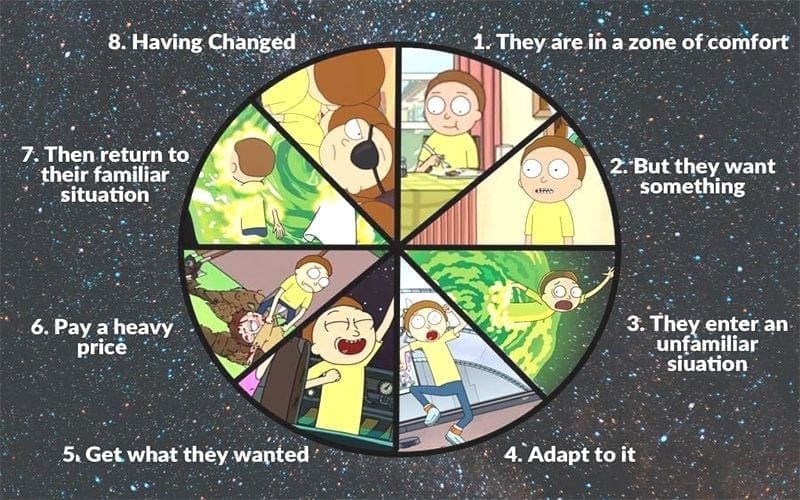
Blake Snyder’s Beat Sheet
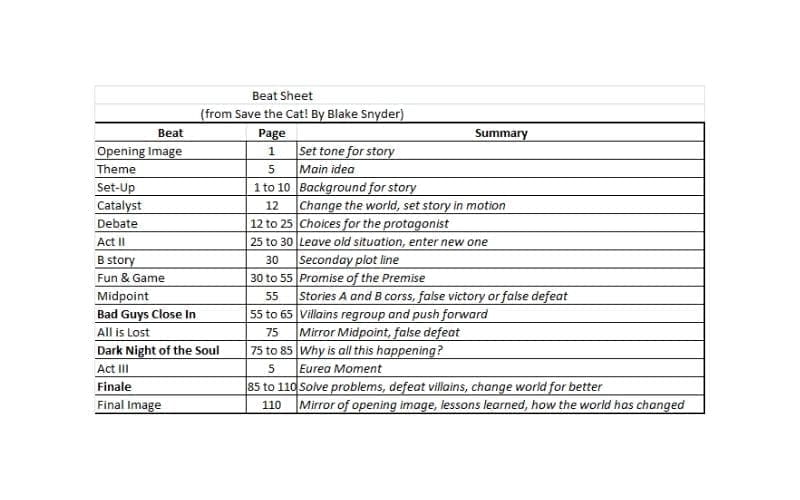
Using these structures can really help you flesh out an idea, and provide a roadmap for where to take your story. It may seem like using these could lead to your story becoming formulaic or feeling predictable, but if you use them properly, they can actually open up loads of opportunities to get creative. Most importantly though, using narrative structure will minimise the amount of time spent staring at a blank screen, because you always know what story beat or plot point needs to come next.
What Other Ways Are There To Plan A Script?
In addition to a treatment, a lot of scriptwriters tend to use an outline when they’re planning. An outline is a scene by scene (or beat by beat) breakdown of your story; taking all of the information in your treatment and putting it in the order that it’ll appear in the final script. You can even include a brief description of what will happen in each scene.
Outlines are really helpful to visualise the flow of your script and can let you spot any continuity issues there may be. They’re also useful if you need to rejig the order of scenes. It’s always easier to swap single lines around than it is to reorder your whole screenplay. Combined with narrative structure, an outline will become your biggest ally in the fight against writer’s block.
How To Write A Movie Script
Now that you’ve taken things step by step from a basic idea through to an outline, it’s time to get that masterpiece written. But how to develop a screenplay in real time?
If you are looking into how to write a musical script, these formats are set in very specific ways and look very different from other types of writing. The main reason is to provide an industry-wide standard, so that it’s simpler to break a script down in terms of locations, amount of action/dialogue, and page length (which roughly equates to runtime).
Another reason to correctly format your script comes if you’re ever trying to pitch your screenplay. A poor music script format is the quickest way to indicate your lack of competence, and could potentially put the reader off from the get-go. It’s important to get it right.
The easiest way to format a screenplay is to simply let your screenwriting software do it for you. This obviously makes things easier for you but there are still things you need to know when starting your script.
Font
Always use 12-point Courier, or a slight variation of, such as Courier Prime.
Scene Headings
When writing scene headings, you should always follow this format, minus the brackets: [INT/EXT. LOCATION – DAY/NIGHT]. It should always be in capitals, and every major location change in the script needs a new scene heading. The only minor variation on this music script format, is when you have a character walking directly from one location, to another location. When this occurs you should use CONTINUOUS instead of DAY or NIGHT. It can be good to put scene headings in bold to make them stand out, but this isn’t strictly necessary.
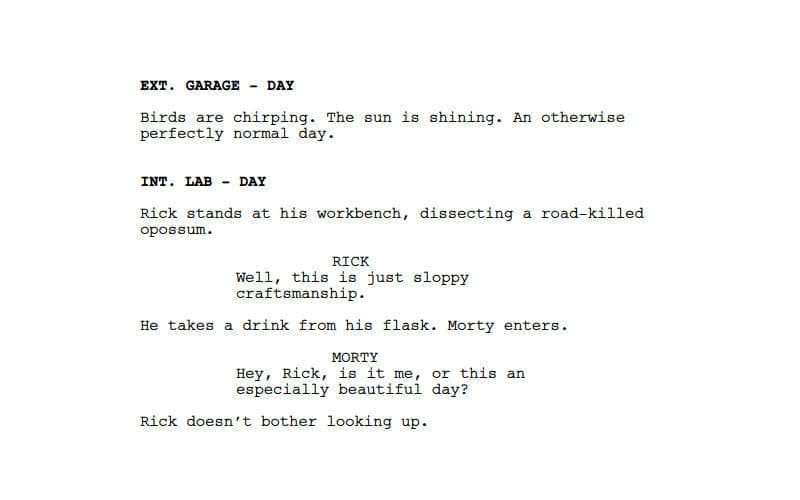
Action
Action, like the scene heading, is aligned to the left of the page but should be lowercase. If there are important props, sound effects, or costumes that appear in the script, then you can capitalize these. This makes sure department heads don’t miss them when they’re breaking down the script.
It’s important to note that with action, you can keep it short and to the point. You’re not writing a Game of Thrones novel so keep the two-page description of a woman’s looks to yourself.
Dialogue
Dialogue is where things get a little spicy. The character name, and subsequent dialogue, should be centre-aligned. Character names are always capitalized, and if you need to put emphasis on a certain word, then underline it instead of capitalizing it.
If you want to have one character interrupt another character, then you can use consecutive hyphens [–] at the point in their dialogue that they get interrupted.
Parentheses
The parentheses (or brackets) are a hugely useful tool when trying to indicate how a character should say a certain piece of dialogue. You can also put basic pieces of action inside of parentheses to be economic on the page. This only requires one new line as opposed to the four that a fresh line of action would take up. Screenwriting is all about efficiency after all (to a producer, more pages means more money).
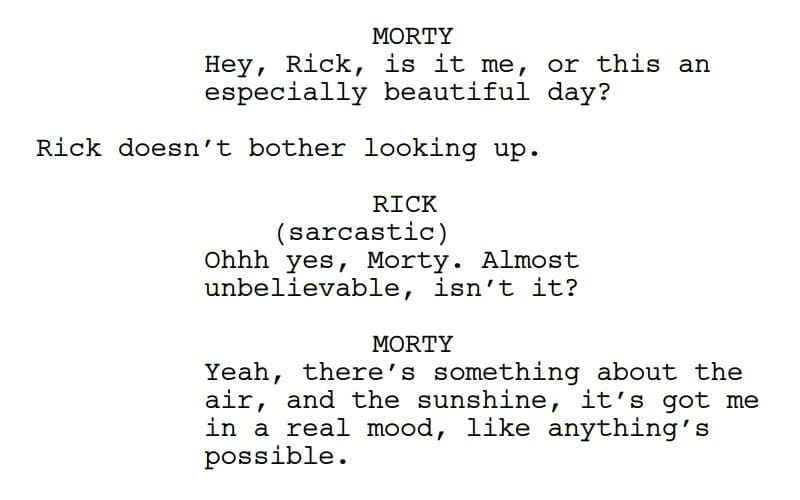
How To Write A Flashback In A Script
There are of course times when you need to write a specific storytelling or cinematic device into your screenplay, such as a flashback or slow-motion. Luckily, both of these techniques follow a similar format.
For a flashback, if it just takes place within a single scene, you can simply add the word FLASHBACK in parentheses at the end of your scene heading. If the flashback takes place across multiple scenes, you can add BEGIN FLASHBACK: before you jump into the first scene of the flashback. Then, once the flashback has finished, you can write END FLASHBACK before writing the scene heading for the next (present-day) scene.
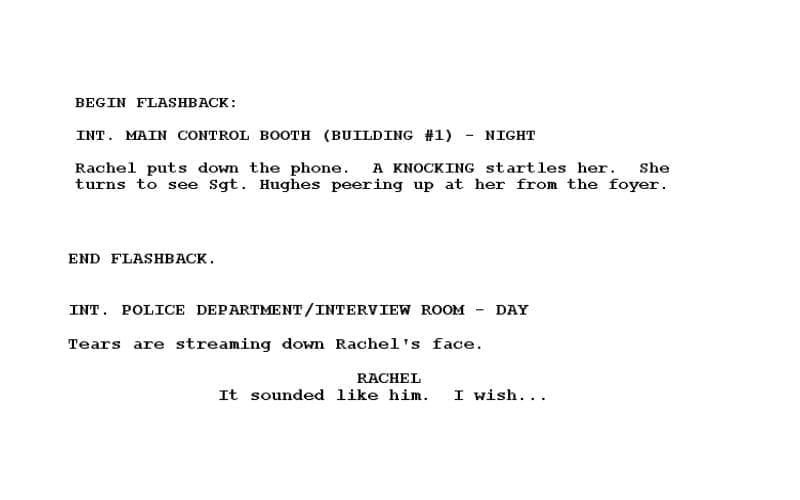
As mentioned, writing slow-motion follows a similar pattern. Preface the action that you want in slow motion with BEGIN SLOW MOTION: then once the slow-motion action has finished, write END SLOW MOTION. It should be noted that it’s generally considered bad form to write camera angles and techniques into the script, as this can sometimes be seen as telling the director how to do their job. There are, of course, times when it’s absolutely necessary for the story, and in these instances, it’s totally fine to do so.
How To Write A Script For A TV Show
All of the previous points still hold true for TV show scripts, with just a couple of additions. In a TV script, act breaks are actually written into the script. Not to be confused with the narrative acts mentioned earlier, these act breaks are to demonstrate where the title sequence, commercial breaks and end credits will appear.
For a half-hour sitcom:
- Cold Open (scene before title sequence)
- Act One (after title sequence but before ad break)
- Act Two (after ad break)
- Tag (post credits scene)
For an hour-long drama:
- Teaser (scene before title sequence)
- Act One (after title sequence)
- Two (after first ad break)
- Three (after second ad break)
- Four (after third ad break)
- Five (after fourth ad break)
These act breaks should all be centre-aligned, uppercase, bold, and underlined. They should be used at the start and end of each act, and every new act starts on a fresh page.
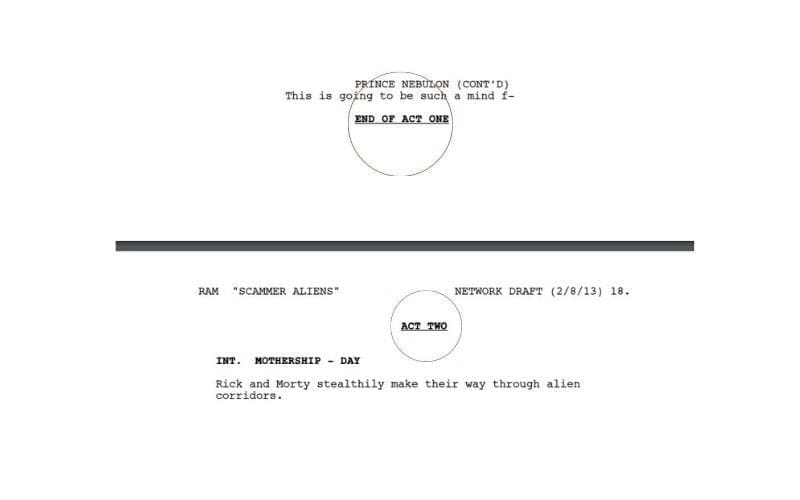
There’s one other type of TV script that is formatted slightly differently. This is the multi-camera script, for shows that are shot in front of a live audience (think Friends, Big Bang Theory etc.). They do this mostly for technical reasons related to the fact that they’re being shot more like a piece of theatre than a movie or traditional TV show. There are a few ways in which these scripts are formatted differently, but the main ones are as follows:
- Scene headings are underlined
- All of the action is capitalized
- Character names are underlined when the character first appears
- The script includes stage directions such as character entrances and exits
- Sounds and special effects are underlined
- Image of multi-camera script
How to Write A Play Script
Writing a play script, on the other hand, requires a different set of formatting rules altogether. They are, however, the forefather of film and TV scripts, so they don’t look completely alien. The main differences are:
- Both act and scene headings are centred
- Stage directions are indented one tab and italicised
- Character names in stage directions are capitalized
- Image of stage play script
What To Do After You’ve Finished Writing Your Script?
Now, hopefully, you’ve used all of these tools and techniques to finish off your script, what next? Well, the saying that “writing is rewriting” comes to mind. Once it feels like you’ve taken your script as far as you can, then it’s time to get feedback.
Friends and family are always a good place to start. Just be careful though, you don’t want anyone sugarcoating their feedback, so maybe don’t send it to your loving mother.
Other good places to receive notes are script reading services. These tend to be run by people who really know what they’re talking about, and their insights can be hugely beneficial. The downside is that they can be a bit pricey. If you’re looking for low-cost solutions, then Coverfly is a great way to get good quality feedback from other aspiring writers.
Now You Know How To Write A Script
Hopefully, you’ve found this scriptwriting guide useful. You should now have all the tools needed to plan, structure, and write your script. More importantly, you should now know how to write a good script.
Once your script is finally written, then it’s time to go into production! If you’ve been here learning how to write a script for a short film, that is. If it’s a TV show pilot, or feature film script you’ve been writing, then it’s time to get hustling and sell that masterpiece! Good luck!
Music Gateway – Music Lincensing Opportunities
Would you like to get in touch with Music Gateway to see how we can help you? Then please use this link to get in touch with us to discuss any opportunities such as Sync Licensing, Music Licensing, Music Clearance, Sync Libraries or Music Libraries, etc., you may want to take further.
You can book a call with Sam – Head of Sync Licensing – as a potential lead. We are always happy to talk to musicians like you. Please do get in touch.
If you are interested in the crossover between music and film, check out our article on music supervisors. With our concierge and service and extensive music library, allow us to help you find music for your film.









